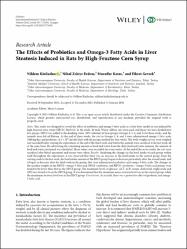| dc.contributor.author | Kızılaslan, Nildem | |
| dc.contributor.author | Erdem, Nihal Zekiye | |
| dc.contributor.author | Katar, Muzaffer | |
| dc.contributor.author | Gevrek, Fikret | |
| dc.date.accessioned | 2022-04-29T05:58:11Z | |
| dc.date.available | 2022-04-29T05:58:11Z | |
| dc.date.issued | 2022 | en_US |
| dc.identifier.citation | Kızılaslan, N., Erdem, N. Z., Katar, M. ve Gevrek, F. (2022). The effects of probiotics and Omega-3 fatty acids in liver steatosis induced in rats by high-fructose corn syrup. International Journal of Clinical Practice, 2022. https://doi.org/10.1155/2022/7172492 | en_US |
| dc.identifier.issn | 1368-5031 | |
| dc.identifier.issn | 1742-1241 | |
| dc.identifier.uri | https://doi.org/10.1155/2022/7172492 | |
| dc.identifier.uri | https://hdl.handle.net/20.500.12511/9388 | |
| dc.description.abstract | Aims. This study was designed to reveal the effect of probiotics and omega-3 fatty acids in a fatty liver model in rats induced by high-fructose corn syrup (HFCS). Methods. In the study, 40 male Wistar Albino rats were used, and these rats were divided into five groups. HFCS was added to the drinking water (30% solution) of four groups (Groups 2, 3, 4, and 5) for three weeks, and the animals were fed ad libitum. At the end of three weeks, the rats in Groups 3, 4, and 5 were administered omega-3 fatty acids (400 mg/kg) and probiotics (1.5 x 10(9) cfu/mL/day) with the gavage method for four weeks. The body weights of rats were weighed and recorded before starting the experiment, at the end of the third week, and before the animals were sacrificed at the last week, all at the same hour. By subtracting the remaining amount of food and water from the daily food and water amount, the amount of food and water consumed was calculated. These values were recorded for seven weeks. At the end of the seven weeks, the rats were sacrificed after blood specimens and tissues were taken. Results. Analyzing the changes in the food intake of each group within itself throughout the experiment, it was observed that there was an increase in the food intake in the control group; from the starting week to the last week, the food intake amount of the HFCS group began to decrease particularly after the second week; and it began to decrease after the third week in the groups that were administered probiotics and omega-3 fatty acids. The changes in the sacrifice weights in the HFCS + omega-3 fatty acid, HFCS + probiotic, and HFCS + probiotic + omega-3 fatty acid groups were found to be lower than that in the HFCS group. The maximum levels of glucose, ALT, ALP, serum cholesterol, triglyceride and AST were found to be in the HFCS group. It was determined that the minimum mean steatosis level was in the control group, while the maximum steatosis level was in the HFCS group. Conclusions. As a result, there was a protective effect of probiotic and omega-3 fatty acid. | en_US |
| dc.language.iso | eng | en_US |
| dc.publisher | Wiley | en_US |
| dc.rights | info:eu-repo/semantics/openAccess | en_US |
| dc.rights | Attribution 4.0 International | * |
| dc.rights.uri | https://creativecommons.org/licenses/by/4.0/ | * |
| dc.subject | High-Fructose Corn Syrup | en_US |
| dc.subject | Omega-3 | en_US |
| dc.subject | Probiotics | en_US |
| dc.subject | Liver Steatosis | en_US |
| dc.title | The effects of probiotics and Omega-3 fatty acids in liver steatosis induced in rats by high-fructose corn syrup | en_US |
| dc.type | article | en_US |
| dc.relation.ispartof | International Journal of Clinical Practice | en_US |
| dc.department | İstanbul Medipol Üniversitesi, Sağlık Bilimleri Fakültesi, Beslenme ve Diyetetik Bölümü | en_US |
| dc.authorid | 0000-0001-7046-9515 | en_US |
| dc.identifier.volume | 2022 | en_US |
| dc.relation.publicationcategory | Makale - Uluslararası Hakemli Dergi - Kurum Öğretim Elemanı | en_US |
| dc.identifier.doi | 10.1155/2022/7172492 | en_US |
| dc.institutionauthor | Erdem, Nihal Zekiye | |
| dc.identifier.wosquality | Q2 | en_US |
| dc.identifier.wos | 000778914300033 | en_US |
| dc.identifier.scopus | 2-s2.0-85131703354 | en_US |
| dc.identifier.pmid | 35685520 | en_US |
| dc.identifier.scopusquality | Q2 | en_US |



















